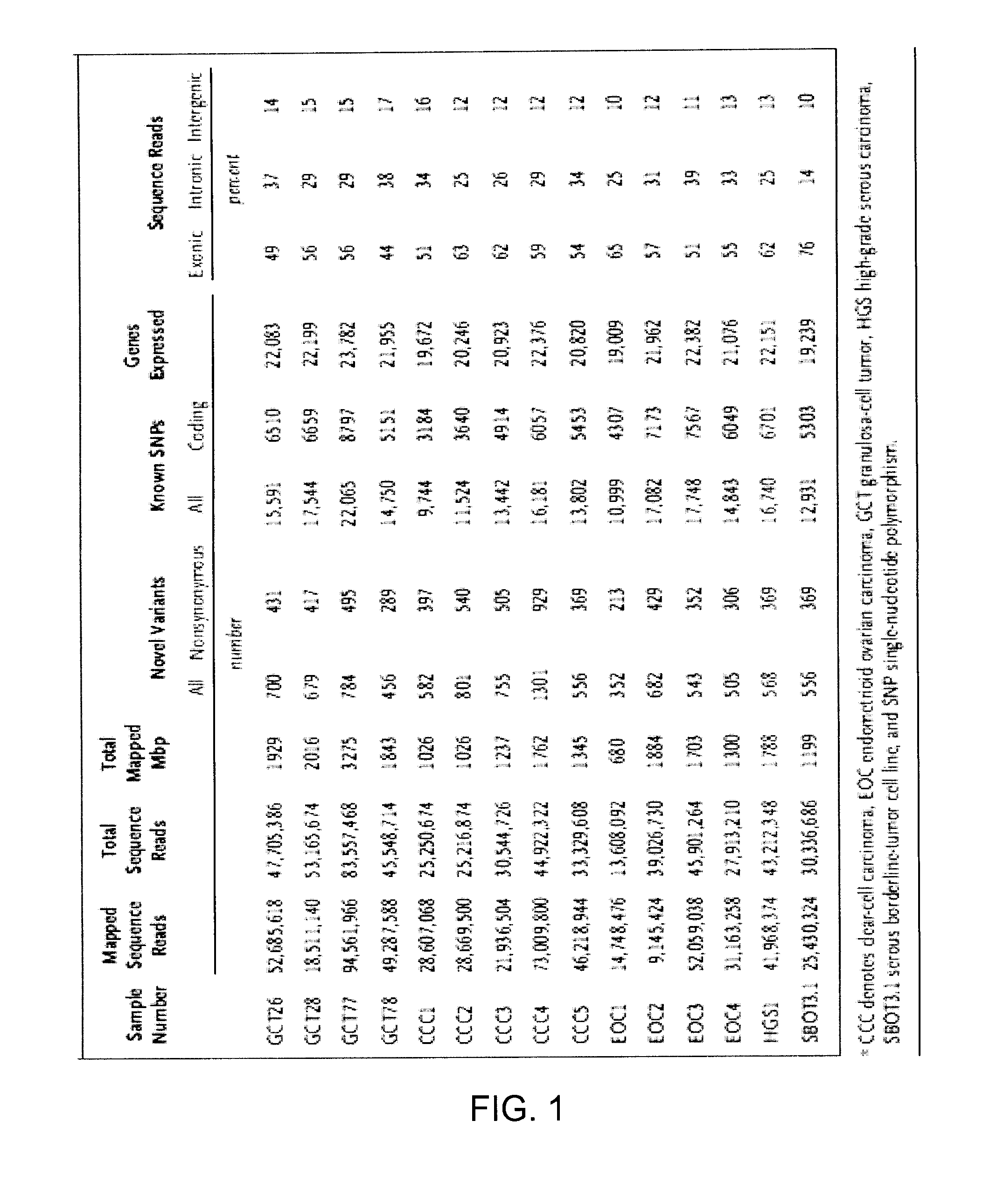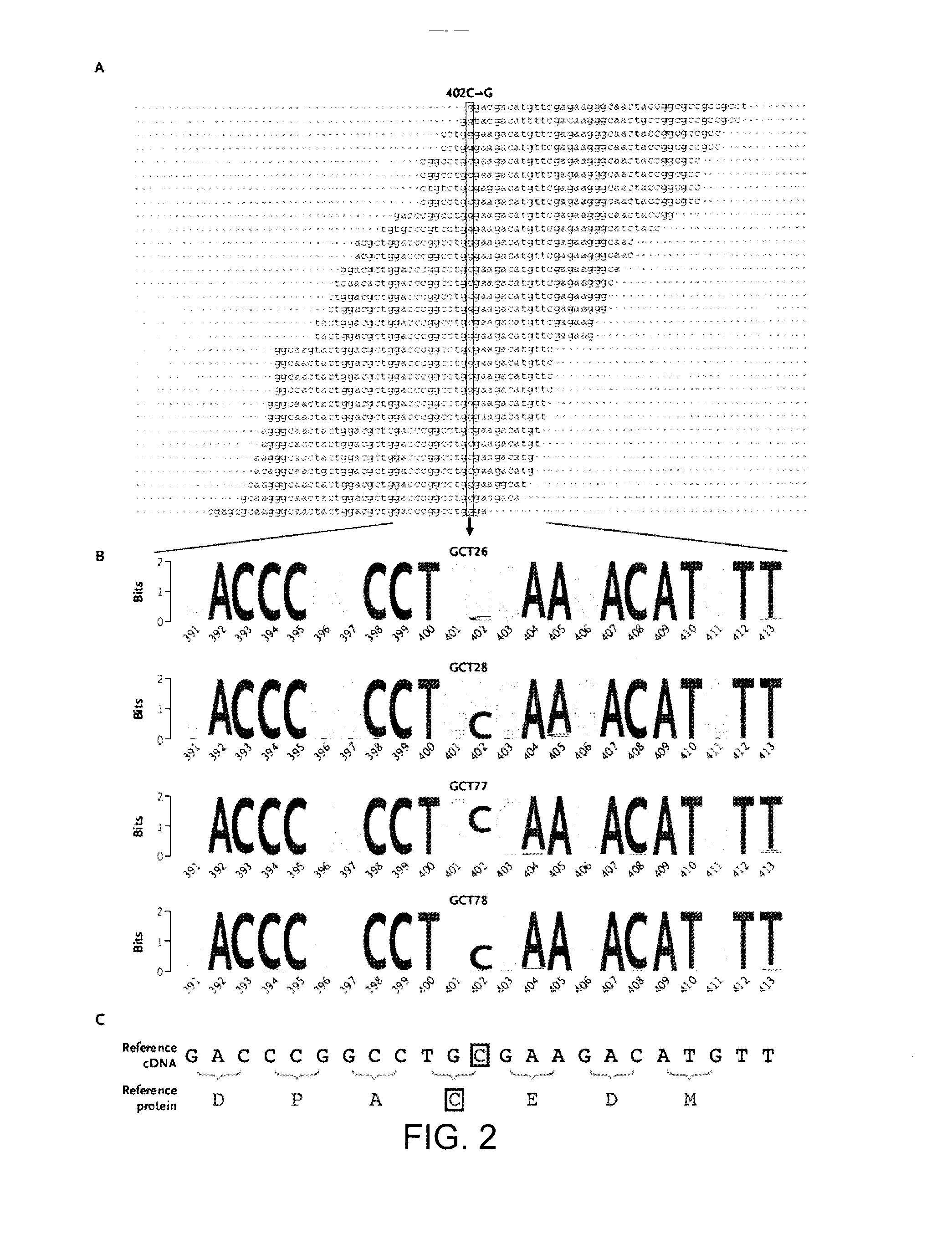Detection of granulosa-cell tumors
a granulosa cell and tumor technology, applied in the field of diagnosis and treatment of cancer, can solve the problems of ovarian cancer, poor survival rate, and significant mortality of women from ovarian cancer
- Summary
- Abstract
- Description
- Claims
- Application Information
AI Technical Summary
Benefits of technology
Problems solved by technology
Method used
Image
Examples
example 1
[0051]FOXL2 Gene in Granulosa-Cell Tumor Samples
[0052]Granulosa tumor samples were compared with control ovarian carcinoma tumor samples to observe the presence of FOXL2 gene.
[0053]Methods. Using the Illumina™ sequencing platform the FOXL2 gene was sequenced in 7 granulosa tumor samples and 10 control ovarian carcinoma tumor samples. In addition the germline FOXL2 gene was sequenced in patients with granulosa-cell tumors.
[0054]Results. The identical missense point mutation was identified in 7 of the 7 granulosa-cell tumors assessed. The mutation is TGC→TGG (or “TGC>TGG”) resulting in a C→W amino acid change at position 134.
[0055]Table 1 illustrates sequence results from an initial 4 unique samples, indicating for each granulosa-cell tumor (GCT) sample, a TGC→TGG mutation was found, resulting in substitution of W for C in FOXL2. By contrast this mutation was not detected in any of the control ovarian carcinoma tumor samples. The mutation was not detected in the germline of the patien...
example 2
[0058]Mutation of FOXL2 in Granulosa-Cell Tumors of the Ovary
[0059]Summary. In this example, four adult-type GCTs were analysed using whole-transcriptome paired-end RNA sequencing. Putative GCT-specific mutations were identified that were present in at least three of these samples but were absent from the transcriptomes of 11 epithelial ovarian tumors, published human genomes, and databases of single-nucleotide polymorphisms. These variants were confirmed by direct sequencing of complementary DNA and genomic DNA. Additional tumors and matched normal genomic DNA were then analysed for comparison, using a combination of direct sequencing, analyses of restriction fragment-length polymorphisms, and TaqMan assays. All four index GCTs had a missense point mutation, 402C>G (C134W), in FOXL2, a gene encoding a transcription factor known to be critical for granulosa-cell development. The FOXL2 mutation was present in 86 of 89 additional adult-type GCTs (97%), in 3 of 14 thecomas (21%), and i...
example 3
[0088]The Specificity of the FOXL2 402C>G Somatic Mutation: A Survey of Solid Tumors.
[0089]Summary. In this Example, the somatic mutation in the FOXL2 gene which was present in almost all (97%; 86 / 89) morphologically defined adult-type granulosa-cell tumors in Example 2 was investigated further for specificity. This FOXL2 402C>G mutation changes a highly conserved cysteine residue to a tryptophan (C134W). It was also found in a minority of other ovarian malignant stromal tumors but not in benign ovarian stromal tumors or unrelated ovarian tumors or breast cancers. In this Example, other cancers and cell lines were assessed for the presence of this mutation. DNA from 752 tumors of epithelial and mesenchymal origin and 28 ovarian cancer cell lines and 52 other cancer cell lines of varied origin were screened. The FOXL2 402C>G mutation was found in an unreported A-GCT case and the A-GCT-derived cell line KGN. All other tumors and cell lines analyzed were mutation negative. In addition ...
PUM
| Property | Measurement | Unit |
|---|---|---|
| plasma | aaaaa | aaaaa |
| fluorescence detection | aaaaa | aaaaa |
| lengths | aaaaa | aaaaa |
Abstract
Description
Claims
Application Information
 Login to View More
Login to View More - R&D
- Intellectual Property
- Life Sciences
- Materials
- Tech Scout
- Unparalleled Data Quality
- Higher Quality Content
- 60% Fewer Hallucinations
Browse by: Latest US Patents, China's latest patents, Technical Efficacy Thesaurus, Application Domain, Technology Topic, Popular Technical Reports.
© 2025 PatSnap. All rights reserved.Legal|Privacy policy|Modern Slavery Act Transparency Statement|Sitemap|About US| Contact US: help@patsnap.com


